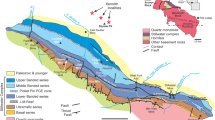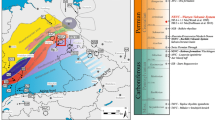Abstract
Approximately 150 km west of Mexico City in the central part of the Mexican Volcanic Belt (MVB) near Zitácuaro, Mexico, young volcanism has produced shield volcanoes, large volume silicic deposits, and fault-related basalt and andesite lava flows and cinder cones. This paper concerns a small cluster of Pleistocene andesite cones and flows which can be separated into two distinct groups: high-magnesium andesites (>6% MgO, 57–59% SiO2), conveniently called basaltic andesites, with phenocrysts of orthopyroxene and augite, or augite and olivine; and andesites (60–62% SiO2, <4.6% MgO), which have phenocrysts of orthopyroxene and augite, and ghosts of relict hornblende. Remarkably, plagioclase phenocrysts are absent, and evenly distributed but sparse (0.5–3.5%) quartz xenocrysts are present in all the lavas. In order to establish the conditions under which early crystallizing plagioclase is suppressed in these lavas, water saturated experiments up to 3 kbars were performed on one of the basaltic andesites. The conditions required to reproduce the phenocryst assemblages (either olivine + augite or opx + augite) are temperatures in excess of 1000 °C, with water saturated liquids (>3 wt%) at pressures of about 1 kbar. Compared to basaltic andesites of western Mexico, the Zitácuaro basaltic andesites have ∼2 wt% lower Al2O3 concentrations, which causes plagioclase to precipitate at significantly lower temperatures, and it therefore follows the crystallization sequence: olivine, augite, and orthopyroxene. Based on ubiquitous quartz xenocrysts, with glassy rhyolitic inclusions, a reasonable conclusion is that substantial mixing of a quartz-bearing rhyolitic magma with a parental basaltic andesite has occurred at low pressure (shallow depth), and this would account for the low Al2O3 concentrations in the Zitácuaro basaltic andesites. Whatever the mechanism of incorporation, the quartz xenocrysts are evidence of contamination of basaltic magma with more siliceous material, thus making it difficult to use these magmas as indicators of mantle melting processes.
Similar content being viewed by others
Author information
Authors and Affiliations
Additional information
Received: 29 July 1997 / Accepted: 29 January 1998
Rights and permissions
About this article
Cite this article
Blatter, D., Carmichael, I. Plagioclase-free andesites from Zitácuaro (Michoacán), Mexico: petrology and experimental constraints. Contrib Mineral Petrol 132, 121–138 (1998). https://doi.org/10.1007/s004100050411
Issue Date:
DOI: https://doi.org/10.1007/s004100050411




